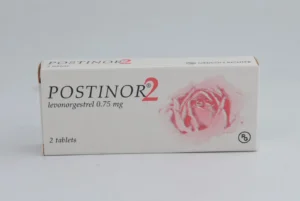Side Effects of postinor 2 on the womb: Postinor 2, a common emergency contraceptive pill (ECP), is widely used to prevent unintended pregnancy after unprotected sex. However, many women express concern about its impact on the womb (uterus), especially regarding long-term reproductive health.

The internet is filled with claims and myths such as:
-
“Postinor 2 damages the womb”
-
“It causes infertility”
-
“It thins the uterus lining permanently”
These statements often lack medical backing and contribute to confusion and fear.
In this article, we separate facts from myths, focusing on:
-
How Postinor 2 works
-
Its direct effects on the womb
-
Potential short- and long-term side effects
-
Fertility implications
-
Who should and shouldn’t use it
Side Effects of postinor 2 on the womb
Postinor 2 is an emergency contraceptive containing levonorgestrel, a synthetic form of progestin. It’s designed to:
-
Delay ovulation
-
Interfere with fertilization
-
Prevent implantation of a fertilized egg
It does not terminate an existing pregnancy and is most effective within 72 hours after unprotected sex.
How Does Postinor 2 Affect the Womb?
1. Temporary Endometrial Changes
Postinor 2 can temporarily alter the lining of the womb (endometrium). This may:
-
Prevent the fertilized egg from attaching to the uterine wall
-
Cause irregular shedding (leading to spotting or early menstruation)
⚠️ These changes are reversible and usually reset in your next cycle.
2. No Structural Damage
There is no scientific evidence showing that Postinor 2 causes:
-
Uterine scarring
-
Womb thinning
-
Fibroids
-
Endometrial atrophy (permanent thinning of the uterine lining)
3. No Impact on Future Implantation
Once your cycle returns to normal, the uterus regains full functionality. It does not reduce your chances of getting pregnant in the future unless you misuse or overuse it frequently (see below).
Short-Term Side Effects on the Uterus
Some women experience mild and temporary effects related to the womb, such as:
| Symptom | Explanation |
|---|---|
| Cramping or Uterine Pain | Due to hormonal shifts that mimic menstruation |
| Breakthrough Bleeding | Result of endometrial shedding post-dose |
| Delayed or Early Period | Changes in uterine lining timing |
These are normal and resolve within 1–2 weeks.
Long-Term Side Effects on the Womb: Are There Any?
When used occasionally and correctly, Postinor 2 has no proven long-term side effects on the womb.
However, with repeated use, some risks include:
-
Irregular Menstrual Cycles
Frequent hormonal disruption may cause your womb lining to behave unpredictably. -
Hormonal Imbalance
Overuse could confuse the natural estrogen-progesterone cycle that regulates uterine lining health. -
Menstrual Suppression
In rare cases, excessive use may lead to missed or light periods for several months — but this is reversible. -
Perception of “Womb Weakness” (Unfounded)
Some anecdotal beliefs claim the womb becomes “weak” or “thin” after Postinor use — there is no scientific backing for this.
Does Postinor 2 Cause Infertility?
No. The World Health Organization (WHO) and reproductive health experts agree:
Postinor 2 does not cause infertility or permanent damage to the uterus.
Its components leave your body within days, and fertility usually resumes quickly — often in the same cycle.
However, relying on emergency contraception frequently may cause cycle irregularities that confuse ovulation timing, but not fertility per se.
Clinical Opinions
🩺 Dr. Caroline West, Reproductive Endocrinologist:
“Postinor 2 acts on hormonal pathways to delay ovulation. Its effects on the womb lining are short-lived and do not cause scarring or permanent change.”
🩺 WHO Guidelines on Emergency Contraception:
“Emergency contraceptives, including levonorgestrel-based pills, are safe, with no long-term impact on uterine health or future fertility.”
When Should You Be Concerned?
Contact your doctor if you notice:
-
Severe lower abdominal pain (possible ectopic pregnancy)
-
No period within 3 weeks
-
Heavy or prolonged bleeding
-
Menstrual cycles disrupted for more than 3 months
These symptoms may be unrelated to the womb but still warrant investigation.
Tips for Safe Use Without Womb Complications
✅ Take only when necessary – Not more than once per cycle
✅ Use other protection – Transition to long-term contraceptives if you’re sexually active
✅ Do not rely on myths – Only trust advice from qualified medical professionals
✅ Track your periods – Irregular cycles can help you detect hormone imbalance or ovulatory issues
Safer Alternatives for Uterine Health
If you’re concerned about the womb:
-
Copper IUD: Non-hormonal, long-term, uterus-safe
-
Condoms: No impact on hormonal or uterine health
-
Implants: Minimal systemic hormonal impact
-
Natural family planning (requires cycle tracking)
Summary Table
| Concern | Truth |
|---|---|
| Damages womb lining permanently | ❌ No scientific evidence |
| Causes infertility | ❌ False |
| Disrupts period short-term | ✅ Yes, may delay or hasten menstruation temporarily |
| Safe for uterus with rare use | ✅ Confirmed by WHO and studies |
| Causes fibroids or cysts | ❌ No direct link |
| Repeated use can affect cycle timing | ✅ True, due to hormonal interference |
Final Thoughts
Postinor 2 is a safe and effective emergency contraceptive when used properly. The notion that it harms the womb is a myth not supported by clinical evidence.
While temporary hormonal changes can affect the endometrial lining, these are not damaging, and fertility remains intact. Responsible use and consulting with a healthcare provider ensure that your reproductive system remains healthy.
References
-
World Health Organization. “Emergency Contraception: Fact Sheet.”
-
Faculty of Sexual and Reproductive Health, UK: Clinical Guidance.
-
American College of Obstetricians and Gynecologists (ACOG).
-
Mayo Clinic – Levonorgestrel Use and Side Effects.
-
NHS UK – Emergency Contraceptive Guidance.